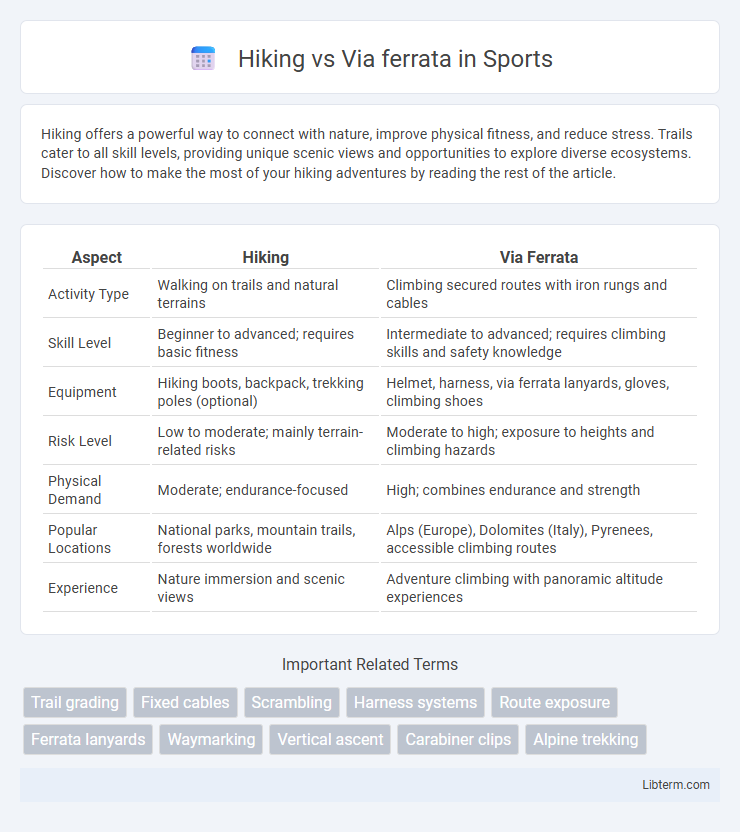Hiking offers a powerful way to connect with nature, improve physical fitness, and reduce stress. Trails cater to all skill levels, providing unique scenic views and opportunities to explore diverse ecosystems. Discover how to make the most of your hiking adventures by reading the rest of the article.
Table of Comparison
| Aspect | Hiking | Via Ferrata |
|---|---|---|
| Activity Type | Walking on trails and natural terrains | Climbing secured routes with iron rungs and cables |
| Skill Level | Beginner to advanced; requires basic fitness | Intermediate to advanced; requires climbing skills and safety knowledge |
| Equipment | Hiking boots, backpack, trekking poles (optional) | Helmet, harness, via ferrata lanyards, gloves, climbing shoes |
| Risk Level | Low to moderate; mainly terrain-related risks | Moderate to high; exposure to heights and climbing hazards |
| Physical Demand | Moderate; endurance-focused | High; combines endurance and strength |
| Popular Locations | National parks, mountain trails, forests worldwide | Alps (Europe), Dolomites (Italy), Pyrenees, accessible climbing routes |
| Experience | Nature immersion and scenic views | Adventure climbing with panoramic altitude experiences |
Introduction to Hiking and Via Ferrata
Hiking involves walking on natural trails and terrains, emphasizing physical endurance and exploration through forests, mountains, and valleys. Via ferrata combines hiking with climbing, featuring fixed cables, ladders, and bridges installed on rock faces to aid climbers in reaching difficult summits safely. Both activities offer unique outdoor experiences, with hiking focusing on trail navigation and via ferrata providing a controlled climbing adventure.
Key Differences Between Hiking and Via Ferrata
Hiking primarily involves walking on natural trails and varying terrains using basic gear such as sturdy shoes and backpacks, whereas via ferrata requires specialized equipment like harnesses, helmets, and carabiners to navigate fixed steel cables, ladders, and bridges on steep rock faces. The physical demands of via ferrata are typically higher, combining elements of climbing and scrambling, while hiking emphasizes endurance and navigation over diverse landscapes. Safety risks are more significant in via ferrata due to exposure and technical sections, necessitating proper training and equipment knowledge compared to the generally lower-risk activity of hiking.
Required Skills and Experience Levels
Hiking requires basic physical fitness, trail navigation skills, and minimal technical knowledge, making it accessible for beginners and casual outdoor enthusiasts. Via ferrata demands advanced climbing skills, experience with safety equipment such as harnesses and carabiners, and the ability to handle exposure to heights, suitable for those with intermediate to expert levels in mountain activities. Proper training in rope techniques and familiarity with routes enhance safety and enjoyment in via ferrata excursions compared to standard hiking trails.
Essential Gear for Each Activity
Hiking requires essential gear such as sturdy hiking boots, weather-appropriate clothing, a backpack with water, snacks, a map, and a first aid kit to ensure safety and comfort on trails. Via ferrata demands specialized equipment including a helmet, climbing harness, via ferrata lanyard with energy absorber, gloves, and secure footwear designed for rocky terrain and vertical climbs. Proper gear selection enhances safety and performance tailored to the unique challenges of hiking paths versus the technical routes of via ferrata.
Physical and Mental Benefits
Hiking improves cardiovascular health, enhances muscle endurance, and reduces stress by promoting mindfulness through nature immersion. Via ferrata combines strength, balance, and coordination challenges, boosting mental focus and confidence by navigating secured climbing routes. Both activities foster resilience and mental well-being through physical exertion and problem-solving in outdoor environments.
Safety Considerations and Risk Factors
Hiking typically involves lower risk factors, with safety largely dependent on trail conditions, weather, and proper equipment such as sturdy footwear and navigation tools. Via ferrata presents higher safety considerations due to exposure on steep, vertical terrain requiring specialized gear like harnesses, helmets, and carabiners to prevent falls. Both activities demand awareness of physical fitness levels and environmental hazards to minimize accidents and ensure a secure outdoor experience.
Accessibility and Suitable Locations
Hiking trails generally offer greater accessibility, accommodating a wide range of skill levels and requiring minimal specialized equipment, making them suitable for various terrains such as forests, mountains, and national parks. Via ferrata routes are less accessible due to essential climbing gear and safety training, typically found in alpine regions with rocky cliffs and steep vertical sections ideal for experienced adventurers. Both activities cater to outdoor enthusiasts, but hiking provides broader location options and easier entry for beginners, while via ferrata offers challenging, secured climbing experiences in specific mountainous locations.
Environmental Impact and Conservation
Hiking typically exerts a lower environmental impact compared to via ferrata, as it involves minimal alteration to natural landscapes and relies on established trails, reducing habitat disruption and soil erosion. Via ferrata routes require fixed steel cables, ladders, and anchors, which can lead to permanent changes in the rock face and increased human traffic, potentially disturbing local wildlife and vegetation. Conservation efforts emphasize maintaining trail integrity, minimizing infrastructure expansion, and promoting Leave No Trace principles to protect sensitive ecosystems affected by both activities.
Choosing the Right Adventure for You
Choosing between hiking and via ferrata depends on your skill level, physical fitness, and appetite for adrenaline. Hiking offers a more accessible, low-risk experience with scenic trails ideal for nature lovers, while via ferrata combines climbing and hiking, requiring specialized equipment and providing a thrilling challenge for adventure seekers. Assess your comfort with heights, technical gear, and physical endurance to select the adventure that matches your experience and goals.
Final Thoughts: Which is Better?
Hiking offers a versatile outdoor experience suitable for all skill levels, emphasizing endurance and connection with nature, while via ferrata provides a thrilling, adrenaline-fueled climb using fixed cables and ladders, ideal for adventure seekers with some technical ability. Choosing between hiking and via ferrata depends on your fitness, risk tolerance, and desire for excitement or tranquility. For a safer and more accessible option, hiking is preferable; for challenge and adrenaline, via ferrata stands out.
Hiking Infographic

 libterm.com
libterm.com